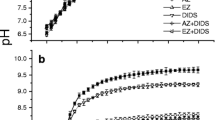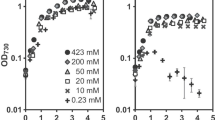Abstract.
The mechanisms for acquisition of dissolved inorganic carbon (DIC) in the red macroalga Gracilaria gaditana nom. prov. have been investigated. The capacity for HCO3 − use by an extracellular carbonic anhydrase (CA; EC 4.2.1.1), and by an anion exchanger with similar properties to that of red blood cells (AE1), has been quantified. It was illustrated by comparing O2 evolution rates with those theoretically supported by CO2, as well as by photosynthesis-pH curves. Both external and internal CA, and a direct uptake were involved in HCO3 − use, since photosynthesis and pH evolution were affected by acetazolamide, 6-ethoxyzolamide (inhibitors of external and total CA, respectively) and 4,4′-diisothiocyanatostilbene-2,2′-disulfonate, (DIDS; an inhibitor of HCO3 − exchanger protein). The activity of the external CA was detected by a potentiometric method and by an alternative method based on the study of O2 evolution after addition of CO2 and acetazolamide. The latter method showed a residual photosynthetic rate due to direct HCO3 − use. Inhibitors caused a reduction in the pH compensation points in pH-drift experiments. The CO2 compensation points for photosynthesis increased when the inhibitors were applied, indicating a suppresion of the pathways involved in the carbon-concentrating mechanism. The net photosynthesis rates as a function of DIC concentration displayed a biphasic pattern that could be supported by the occurrence of the two mechanisms of HCO3 − use. The potential contribution to HCO3 − acquisition by the DIDS-sensitive mechanism was higher after culturing at a high pH. Our results suggest that the HCO3 − use by Gracilaria gaditana is carried out by the two DIC uptake mechanisms. These operate simultaneously with different affinities for DIC, the indirect HCO3 − use by an external CA activity being the main pathway. The presence of a carbon-concentrating mechanism confers eco-physiological advantages in a fluctuating ecosystem subjected daily to high pHs and low DIC concentrations.
Similar content being viewed by others
Author information
Authors and Affiliations
Additional information
Received: 3 July 1998 / Accepted: 30 November 1998
Rights and permissions
About this article
Cite this article
Andría, J., Pérez-Lloréns, J. & Vergara, J. Mechanisms of inorganic carbon acquisition in Gracilaria gaditana nom. prov. (Rhodophyta). Planta 208, 564–573 (1999). https://doi.org/10.1007/s004250050594
Issue Date:
DOI: https://doi.org/10.1007/s004250050594




